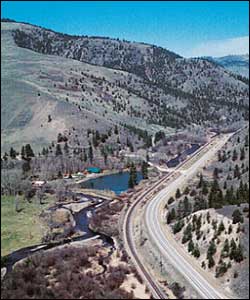















Successes in Stewardship: February 2004 |
|---|

|
Federal Highway Administration
February 2004
Measuring the Timeliness of NEPA: Berger Study Phase II

![]()
In 1969, the National Environmental Policy Act (NEPA) introduced a much-needed framework for protecting the environment from adverse impacts stemming from the actions of Federal agencies. Since then, however, there has been growing concern that the NEPA process can be a cumbersome exercise that impedes project implementation, resulting in increases to projects' schedules and costs and delays to improvements in safety and mobility for travelers. Accordingly, the Federal Highway Administration (FHWA) is undertaking a national initiative to address this concern. The Transportation Equity Act for the 21st Century (TEA-21) Section 1309 mandated Environmental Streamlining as the timely delivery of transportation projects while protecting and enhancing the environment. Furthermore, in Executive Order 13274 Environmental Stewardship and Transportation Infrastructure Project Reviews, President Bush called for the creation of a national task force on environmental streamlining.
The FHWA is committed to addressing the issue of timliness in the NEPA process by setting expectations, measures, and methods for advancing an improved and efficient environmental review process. In January 2001, NEPA professionals at FHWA and the Louis Berger Group compiled "Evaluating the Performance of Environmental Streamlining: Development of a NEPA Baseline for Measuring Continuous Performance" (Berger Study Phase I), a study that began the analysis for setting a benchmark. The study group selected 100 projects at random for which the Environmental Impact Statements (EISs) were completed between the early 1970s and the early 1990s. The focus was on EISs rather than other environmental documentation, such as Environmental Assessments (EAs) or Categorical Exclusions (CEs), because the greatest potential for project delay associated with the environmental review process is related to EISs. Thus, the study group determined that the EIS would be a good gauge of process efficiency.
The Berger Study Phase I found that the mean length of time taken to prepare an EIS during the first 30 years of NEPA (1970-2000) was 3.6+ years, while the median length of time was 3.0 years. Both findings could serve as a reasonable benchmark for evaluating environmental review. However, to determine where delays can occur in the EIS process, the study group wanted a more refined and updated picture of the EIS context.
In 2003, a subsequent report, "Evaluating the Performance of Environmental Streamlining: Phase II" (Berger Study Phase II), was compiled by the same study group. The methodology for conducting this study differed from the Berger Study Phase I in several ways:
The study group conducted statistical analysis of all but 6 of the 250 EISs completed from 1995 to 2001, as identified from Northwestern University's Transportation Library database http://www.library.northwestern.edu/transportation/, which contains more than 4,000 EIS documents from around the country. The team calculated the EIS preparation time by using the official date of the Notice of Intent from the Federal Register as the starting point, and the date of the signing of the Record of Decision as the ending point. Using a variety of statistical techniques, the team concluded that the mean preparation time for an EIS, based on actual NEPA process times, was 5.1 years and the median was 4.7 years. Both of these values were higher that the mean and median values as identified in the Berger Study Phase I.
Other findings were broken down by regions of the United States. The former FHWA Region 4 (Southeast) had the longest EIS preparation time, while former Region 8 (Rocky Mountain states) and former Region 6 (South Central) were found to take the shortest lengths of time. The study group attempted to incorporate process-related variables, such as number of state agencies commenting on the EIS and the requirement of a Coast Guard Bridge permit or a Section 4(f) evaluation. Some trends were identified when assessing length of EIS time in relation to some of these other variables.
The baseline studies described here will contribute to the understanding of the complex environmental review process, providing a benchmark against which other EISs for transportation projects can be measured. Additionally, other tools are being put into place that also address project timeliness. For example, the FHWA internal website hosts an Environmental Document Tracking System (EDTS) that enables users to track and analyze the timeliness of project progress. Individuals in Federal Division Offices and Federal Lands field offices can use EDTS to record and update key project information, set time frames, and monitor the progress of their active EISs and EAs. This level of monitoring will provide useful information about time requirements and factors that hinder project delivery, advancing the development of environmental streamlining performance measures.
Review the Berger Studies Berger Study Phase I http://environment.fhwa.dot.gov/strmlng/baseline/index.asp Berger Study Phase II http://environment.fhwa.dot.gov/strmlng/baseline/phase2rpt.asp Eight Case Studies in Successful Streamlining http://environment.fhwa.dot.gov/strmlng/casestudies/index.asp |
|
Contact Information Kreig (Chip) Larson FHWA Office of Project Development and Environmental Review 400 7th Street SW, Room 3222 Washington, DC 20590 Phone: (202) 366-2056 Fax: (202) 366-7660 Email: Kreig.Larson@fhwa.dot.gov |
|
"Successes in Stewardship" is a Federal Highway Administration newsletter highlighting current environmental streamlining practices from around the country. To subscribe, call (617) 494-6352 or email esnewsletter@volpe.dot.gov. |
